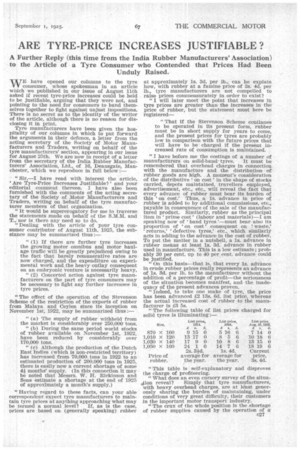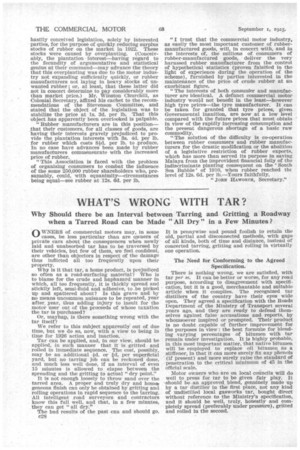ARE TYRE-PRICE INCREASES JUSTIFIABLE?
Page 11

Page 12

If you've noticed an error in this article please click here to report it so we can fix it.
A Further Reply (this time from the India Rubber Manufacturers' Association) to the Article of a Tyre Consumer who Contended that Prices Had Been Unduly Raised.
WE have opened our columns to the tyre consumer, whose spokesman in an article which we published in our issue of August 11th asked if recent tyre-price increases could be held to be justifiable, arguing that they were not, and pointing to the need for consumers to band themselves together to fight against unjust impositions. There is no secret as to the identity of the writer of the article, although there is no reason for disclosing it in print.
Tyre manufacturers have been given the hospitality of our columns in which to put forward the arguments in their defence, a letter from the acting secretary of the Society of Motor Manufacturers and Traders, writing on behalf of the tyre manufacturers' section, appearing in our issue for August 25th. We are now in receipt of a letter from the secretary of the India Rubber Manufacturers' Association, Ltd., of 16, Deansgate, Manchester, which we reproduce in full below :— " Sir,—I have read with interest the article, Are Tyre-Price Increases Justifiable? and your editorial comment thereon. I have also been furnished with the comments of the acting secretary of the Society of Motor Manufacturers and Traders, writing on behalf of the tyre manufacturer members of that organization, "It would be supererogatory for me to traverse the statements made on behalf of the S.M.1L and T., nor is there any need so to do.
"Dealing with the article of your tire consumer contributor of August 11th, 1925, the substance may be summarized thus :— " (1) If there are further tyre increases the growing motor omnibus and motor haulage traffic will be greatly prejudiced owing to the fact that barely remunerative rates are now charged, and the expenditure on experimental work and the heavy outlay consequent on an embryonic venture is necessarily heavy.
" (2) Concerted action against tyre manufacturers on the part of tyre consumers may be necessary to fight any further increasesin tyre prices.
"The effect of the operation of the Stevenson Scheme of the restriction of the exports of rubber from Malaya and Ceylon since its inception on November 1st; 1922, may be summarized thus :— " (a) The supply of rubber withheld from the market is considerably over 250,000 tons.
" (h) During the same period world stocks of rubber available on November 1st, 1922, have been reduced by considerably over 170,000 tons.
" (c) Although the production of the Dutch East Indies (which is non-restricted territory) has increased from 70,000 tons in 1922 to an estimated production of 200,000 tons in 1925, there is easily now a current shortage of some 4imonths' supply. (In this connection it may be noted that Messrs. W. H. Rickinson and Sons estimate a shortage at the end of 1925 of approximately a month's supply.) "Having regard to these facts, can your able correspondent expect tyre manufacturers to maintain tyre prices at anything approaching what may be termed a normal level? If, as is the case, prices are based on (generally speaking) rubber at approximately Is. 3d. per lb., can he explain how, with rubber at a famine price of 3s. 4d. per lb., tyre Manufacturers are not compelled to raise prices commensurately in order to exist?
"I will later meet the point that increases in tyre prices are greater than the increases in the price of rubber, but the statement must here be registered
" That if the Stevenson Scheme continues to be operated in its present form, rubber must be in short supply for years to come, and the present prices for tyres are probably low in comparison with the future prices that will have to be charged if the present increased rate of consumption is maintained.
"I have before me the costings of a number of manufacthrers on solid-bandtyres. It must be remembered that overhead charges in connection with the manufacture and the distribution of rubber goods are high. A moment's consideration of the distributive on cost 'in the shape of stocks carried, depots maintained, travellers employed, advertisement, etc., etc., will reveal the fact that every advance of rubber must bear its burden of this on cost.' Thus, a 1s. advance in price of rubber is added to by additional commissions, etc., payable in consequence of the sale of the manufactured product. Similarly, rubber as the principal item in prime cost' (labour and materials)—I am speaking now of band tyres '—must bear also its proportion of on cost consequent on ' waste,'
returns," defective tyres,' etc., which similarly acts in adding to the advance in the cost of rubber. To put the matter in a nutshell, a is. advance in rubber means at least 1s. 3d. advance in rubber used in manufacture. This is a low estimate; probably 30 per cent, up to 40 per, cent, advance could be justified.
"On this basis--that is, that every Is. advance in crude rubber prices really represents an advance of is. 3d. per lb. to the manufacturer without the addition of a percentage of profit—the seriousness of the situation becomes manifest, and the inadequacy of the present advances proven.
" Indeed, to take one make of tyre, the price has been. advanced f2 13s. Oci. list price, whereas the actual increased cost of rubber to the manufacturer is i3 5s.
"The following table of list prices charged for solid tyres is illuminating :—
"This table is self-explanatory and disproves the charge of profiteering.
"What does an even cursory survey of the situa
ition reveal? Simply that tyre manufacturers, with heavy overhead charges, are at least generously sharing the burden of maintaining, under conditions of very great difficulty, their customers in the important motor transport industry.
"The crux of the whole position is the shortage of rubber supplies caused by the operation of a e27 hastily conceived legislation, solely by interested. parties, for the purpose of quickly reducing surplus stocks of rubber on the market in 1922. These stocks were caused by overplanting. (Conceivably, the plantation interest—having regard to the fecundity of argumentative and statistical genius at their command—may advance the theory that this overplanting was due to the motor industry not expanding sufficiently quickly, or rubber manufacturers not laying in heavy stocks of unwanted rubber ; or, at least, that these latter did not in concert determine to pay considerably more than market price.) Mr. Winston Churchill, as Colonial Secretary, affixed his cachet to the recommendations of the Stevenson Committee, and stated that the object of the legislation was to stabilize the price at is. 3d. per lb. That this object has apparently been overlooked is palpable.
"Rubber manufacturers are in this position— that their customers, for all classes of goods, are having their interests gravely prejudiced to provide the plantation interests with 3s. 4d. per lb. for rubber which costs Sid. per lb. to produce. In no case have advances been made by rubber manufacturers commensurate with the increased price of rubber.
"This Association is faced with the problem of organizing consumers to combat the influence of the some 250,000 rubber shareholders who, presumably, could, with equanimity—circumstances being equal—see rubber at 125. 6d. per lb. "I trust that the commercial motor industry, as easily the most important customer of rubbermanufactured goods, _will, in concert with, and in the interests of, the millions of consumers of rubber-manufactured goods, deliver the very harassed rubber manufacturer from the control of hypothetical statistics (proven falsified in the light of experience during the operation of the scheme), furnished by parties interested in the maintenance of the price of crude rubber at an exorbitant figure.
"The interests of both consul:I:ter and manufacturer are identical. A defunct commercial motor industry would not benefit in the least—however high tyre prices—the tyre manufacturer. It can be taken for granted that tyre prices, given Governmental inanition, are now at a low level compared with the future prices that must obtain In view of the rapidly increasing consumption and the present dangerous shortage of a basic raw commodity.
"The solution of the difficulty is co-operation between rubber consumers and rubber manufacturers for the drastic modification or the abolition of a legislative restriction of rubber exports, which has more than served its purpose in saving Malaya from the improvident financial folly of the Indiscriminate planting consequent on the South Sea Bubble of 1910, when rubber reached the level of 12s. 6d. per lb.—Yours faithfully, "JOHN HAWORTH, Secretary."




























